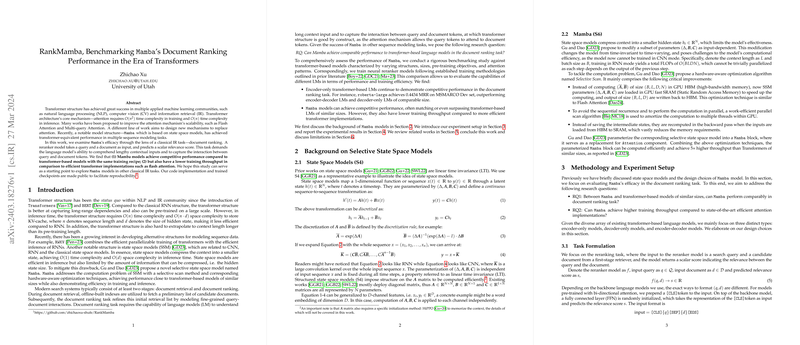Benchmarking Mamba's Document Ranking Performance Against Transformers
Comparative Evaluation of Document Ranking Models
In the sphere of information retrieval (IR), the emergence of transformer-based LLMs has significantly reshaped the way we understand and process natural language data. The paper conducted by Zhichao Xu et al., focuses on evaluating the performance of a recent model structure, Mamba, within the context of the classical IR task of document ranking. The outcomes of this exploration provide nuanced insights into the competitive landscape of LLMs in terms of efficiency and efficacy.
Background and Model Overview
Transformer architectures have heralded advancements across various machine learning applications, notable for their capacity to capture long-range dependencies within sequences. Despite their success, the quadratic computational complexity of the attention mechanism has prompted efforts to devise more scalable alternatives. A noteworthy development in this endeavor is the Mamba model, which operates on the principles of Selective State Space Models (SSMs) to foster transformer-equivalent performance while aiming for superior computational efficiency.
Research Questions and Methodology
The core objective of the paper was to ascertain whether Mamba models could offer performance on par with or superior to transformer-based models in document ranking tasks. The investigation entailed a rigorous benchmarking process, pitting Mamba against a diverse array of transformer-based models, including encoder-only, decoder-only, and encoder-decoder frameworks across different scales. The benchmark focused on models with varying pre-training objectives, sizes, and attention mechanisms, employing established training recipes and evaluating their performance through the lens of the document ranking task. This task necessitates a model's ability to discern and quantify the relevance between queries and documents, demanding both comprehensive understanding and contextual interpretation capabilities from the underlying LLM.
Key Findings
The empirical analysis revealed several critical findings:
- Encoder-only transformer models demonstrated robust performance in document ranking tasks, with roberta-large notably outperforming its counterparts in terms of the MRR metric on the MSMARCO Dev set.
- Mamba models showcased competitive performance, sometimes matching or surpassing the transformer-based models' effectiveness. This is a considerable achievement, emphasizing Mamba's potential in handling complex IR tasks.
- However, it was observed that Mamba models suffer from lower training throughput compared to advanced transformer implementations incorporating efficient attention mechanisms such as Flash Attention.
Implications and Future Directions
The findings from this paper underscore Mamba models' viability as a potent alternative to transformer-based models for document ranking tasks, hinting at their broader applicability across classical IR tasks. Nonetheless, the noted deficiency in training throughput for Mamba models compared to some transformer models signifies a potential area for future optimization. This limitation does not diminish Mamba’s achievements but rather highlights a trajectory for enhancing its implementation to fully leverage its efficiency and scalability advantages.
Advancing Mamba's computational efficiency without compromising its performance could redefine the benchmarks for LLM deployments in IR, offering a blend of efficacy and efficiency. As the IR field continues to evolve, the exploration of models like Mamba, which challenge the status quo and push the boundaries of computational efficiency, remains crucial in our ongoing quest to develop more capable, scalable, and efficient language processing systems.
Concluding Remarks
The paper’s exploration into Mamba models within the domain of document ranking presents a promising avenue for future research. The competitive performance of Mamba models, juxtaposed with their current limitations in training throughput, offers a nuanced perspective on the potential and challenges of deploying SSM-based models in IR tasks. As we move forward, refining these models and overcoming their limitations will be paramount in harnessing their full potential, paving the way for their broader application across the diverse ecosystem of IR tasks.
